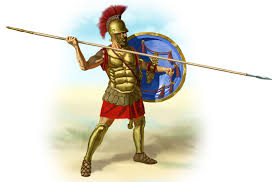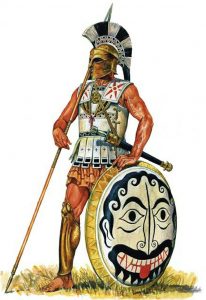Ancient Greece Hoplites: When Ancient Greece emerged from its ‘Dark Age’, the population increased significantly thereby paving the way to an urbanized culture, along with the rise of the city-states referred to as Poli.
Ancient Greece Hoplites
These rapid developments also brought the possibility of organized warfare between the newly formed city-states. Though it was not necessary to engage in any kind of conflict, however, keeping in mind the restless nature of Ancient Greek society, conflict seemed to be somewhat inevitable.

Hoplite Phalanx
Thus, the hoplites soon became a solution to the armed clashes between independent city-states. Closely connected with the rise of the city-state was the evolution of a new way of warfare – the hoplite phalanx. The exact date of the origin of this type of warfare is not known to the historians but it is believed to have been created by the Spartans around 650 BC.
The hoplite was a heavily armored, spear-armed citizen-soldier, primarily drawn from the middle classes. A hoplite was basically a citizen-soldier of the Ancient Greek city-states. Hoplites were primarily spear-men who fought in a phalanx formation.

Hoplite Shield
The word “hoplite” implied the type of the shield used by the soldiers, though, the word, “hoopla” also denoted weapons held or for that matter even full armament. Subsequently, in later texts, the term hoplite was used to denote any armored infantry, irrespective of armament or ethnicity.
Generally speaking, a hoplite was a free citizen who was usually individually responsible for procuring his armor and weapon. In most Greek city-states, citizens received at least basic military training, serving in the standing army for a stipulated period of time. They were expected to take part in any military campaign when they would be called for duty.

Why did hoplites need to spend a lot of time training?
The Lacedaemonian or Spartan citizens were very well known for their life-long combat training and legendary military prowess, while their respective counterparts, the Athenians, were exempted from service only after the 60th year of their lives.
Initially, the hoplites were used only in cases of inter city-state conflicts. However, when the Greek civilization found itself confronted by the world at large, particularly by the Persians, the emphasis in warfare shifted. Confronted by huge numbers of enemy troops, individual city-states were not fully equipped to fight alone.

During the Greco-Persian Wars (499-448 BCE), alliances between groups of cities fought jointly against the Persian forces. This drastically altered the scale of warfare and the numbers of troops involved.
The hoplite phalanx proved itself far superior to the Persian infantry in the Battle of Marathon, Thermopylae as well as the Battle of Plataea. It was during the same period that Athens and Sparta rose to a position of political eminence in Greece, and their rivalry in the repercussion of the Persian wars brought Greece into renewed internal conflict.
However, the Peloponnesian War took the conflicts to an altogether new level. This war was fought between leagues of cities, dominated by Athens and Sparta respectively along with the pooled manpower and financial resources which allowed a diversification of warfare.
More info on- Greek hoplite armor, sword